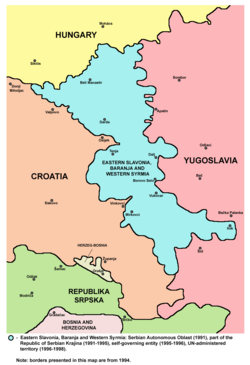
Back منطقة الحكم الذاتي الصربية في سلوفينيا الشرقية وبرانيا وسيرميا الغربية Arabic Сербская аўтаномная вобласць Усходняя Славонія, Баранья і Заходні Срэм Byelorussian Сэрбская аўтаномная вобласьць Усходняя Славонія, Бараня і Заходні Срэм BE-X-OLD SAO Istočna Slavonija, Baranja i Zapadni Srijem BS SAO Východní Slavonie, Baranja a Západní Srem Czech Serbische Autonome Oblast Ostslawonien, Baranja und Westsyrmien German Σερβική Αυτόνομη Περιφέρεια της Ανατολικής Σλαβονίας, Μπαράνια και Δυτικής Σρεμ Greek Eslavonia Oriental, Baranya y Sirmia Occidental Spanish Slavonie orientale, Baranya et Syrmie occidentale French Kelet-Szlavóniai, Baranyai és Nyugat-Szerémségi Szerb Autonóm Terület Hungarian
Serbian Autonomous Oblast of Eastern Slavonia, Baranja and Western Syrmia | |||||||||
|---|---|---|---|---|---|---|---|---|---|
| 1991–1992 | |||||||||
 Eastern Slavonia, Baranja and Western Syrmia | |||||||||
| Status | Self-proclaimed insurgent entity | ||||||||
| Capital | Vukovar | ||||||||
| Government | Interim authority | ||||||||
| Speaker of the People's Assembly | |||||||||
• 1991–1992 | Ilija Končarević | ||||||||
| Historical era | Breakup of Yugoslavia | ||||||||
• Broke away from Croatia | 25 June 1991 | ||||||||
• Incorporated into the Republic of Serbian Krajina | 26 February 1992 | ||||||||
| Currency | Krajina dinar | ||||||||
| |||||||||
Sources: WorldStatesmen.org | |||||||||
| History of Slavonia |
|---|
 |
The Serbian Autonomous Oblast of Eastern Slavonia, Baranja and Western Syrmia (Serbo-Croatian: Srpska autonomna oblast Istočna Slavonija, Baranja i Zapadni Srem, Српска аутономна област Источна Славонија, Барања и Западни Срем) was a self-proclaimed Serbian Autonomous Oblast (SAO) in eastern Croatia, established during the Yugoslav Wars. It was one of three SAOs proclaimed on the territory of Croatia. The oblast included parts of the geographical regions of Slavonia, Baranja, and Syrmia along the Croatian section of the Danube river Podunavlje region.
The entity was formed on June 25, 1991, the same day the Socialist Republic of Croatia decided to withdraw from Yugoslavia, following the Croatian independence referendum, 1991. In the first phase of the Croatian War of Independence, in 1992, the oblast joined the breakaway Republic of Serbian Krajina (RSK) as an exclave and the only part of the RSK directly bordering Serbia. As an ethnically diverse area without predominant majority, the region experienced high levels of interethnic violence and cleansing with the expulsion of large majority of ethnic Croats and numerous other non-Serbs. It was at the same time an area of particularly pronounced external actors involvement in the initiation of and support for the local rebellion compared to other parts of Croatia.
After the fall of the western main portion of RSK in 1995 during the Operation Storm this exclave remained the only area in Croatia under the Serb rebel control. Local authorities in Eastern Slavonia, Baranja and Western Syrmia were convinced to sign the 1995 Erdut Agreement which enabled the peaceful reintegration facilitated by the United Nations Transitional Administration for Eastern Slavonia, Baranja and Western Sirmium.
© MMXXIII Rich X Search. We shall prevail. All rights reserved. Rich X Search

